Don't wanna be here? Send us removal request.
Text
youtube
Update: I was wrong Aleksander Gorbunov retained his pilots seat and Wilmore and Williams flew in the outboard passenger seats
On Sunday Dragon C212 Freedom or USCV-9/SpXC-9 will be flown from the forward port of the station to one 'on top' (the station maintains a certain orientation although it can fly in an attitude and does occasionally). Freedom will move from its current port (as pictured on 7 Oct from the window of the previous crew's Dragon USCV-8/SpXC-8, since departed, then docked at the port Freedom is heading for) to the one above it. This is to allow the next cargo Dragon to dock at the forward port (not sure why put probably to allow access for the giant Dexter robot mounted on the SSRMS robot arm to grab something in the cargo Dragon's 'truck' or rear payload bay). For this flight the two former Starliner crew, Captain Sunita 'Sunny' Williams and Captain Barry 'Butch' Wilmore will take up their seats in Dragon provided for them after USCV-9 launched with only two crew instead of four (the full crew are onboard for these little flights in case of some problem re-docking and they have to return to Earth). I'm assuming Wilmore will take over the role of Pilot from the Russian Aleksander Gorbunov who launched with Dragon Commander Nick Hague (Gorbunov was given some sort of contingency training, in the time available, but not enough to fly the Dragon manually on his own)[I was wrong about that see update above]. Sunny Williams is also now the current station Commander, but NASA astronaut Don Pettit (who launched with the Russian crew on Soyuz MS-26/72S, will still be onboard to look after the US (and partners) side of the station. Pic: NASA Nick Hague. * Sunday 3 November 2024: Flight (Note: US times go back at 02:00am USA) GMT (EST) 11:15 (06:15) TRANSPOSTION FLIGHT COVERAGE NASA+ 11:35 (06:35) undocking N2 Harmony Axil Fwd IDA2 12:18 (07:18) docking N2 Harmony zenith IDA3
Dragon Freedom C212/USCV-9 (revised) CMR Col Nick Hague USSF MS1 Aleksander Gorbunov MS2 Cpt Barry E. Wilmore USN/NASA (CMR Starliner SC3/B-CFT) MS3 Cpt Sunita Williams. USN/NASA (Starliner SC3/B-CFT)(CMR ISS72)
Onboard Crew: Soyuz MS-26/72S FE5 Lt Col Aleksei Ovchinin Russian AF (Soyuz CMR) FE6 Ivan Vagner (Energia) FE7 Donald Pettit NASA
ISS configuartion (Nov flight) SM Zvezda Axil Aft Port: ... Progress MS-28/89P MRM2 Poisk Zenith Port: ... Pogress MS-27/88P UM Prichal all Radial Ports: inactive UM Prichal Nadir Port: empty MRM1 Rassvet Nadir Port: ... Soyuz MS-26/72S N1 Unity Nadir CBM: Cygnus NG-21 N2 Harmony Nadir CBM: empty N2 Harmony Zenith IDA3: (docking) Dragon USCV-9 C212 Freedom N2 Harmony Axil Fwd IDA2: (undocking) Dragon USCV-9 C212 Freedom
0 notes
Text
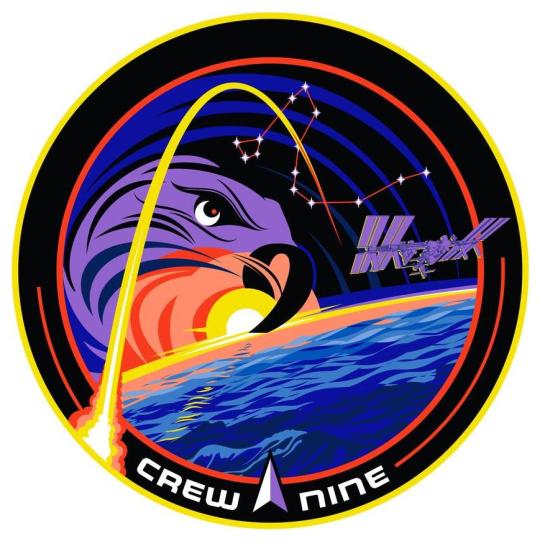
Update 17:36BST. Go for propellent loading. Crew Access Arm retracted, Launch Escape System armed, weather now 70% favourable for launch.
Crew 9 or Dragon USCV-9/SpXC-9 Freedom C212 will be launching today having waited to dodge Hurricane Helena. Or rather what is left of Crew-9, two of the crew have been kicked off this mission so that the abandoned crew of Boeing Starliner can use the empty seats to return home on in February 2025. The original Commander Zena Cardman and Mission Specialist Stephanie Wilson will be reassigned to a, probably much later, mission. This leaves the original Pilot Nick Hague as the new Commander (a bit strange but he is more experienced, possibly Cardman was assigned as Commander to get experience for Artemis missions maybe) and Russian Cosmonaut Aleksander Gorbunov (to assure a Russian presence on the station in the event a problem occurs with Soyuz and NASA does the same, assigning an astronaut to each Soyuz crew).
Being Crew-9 the patch takes the opportunity to celebrate the SpaceX Falcon 9 launch vehicle and the Dragon spacecraft (bad timing for Boeing). Under the arc of the rocket trail flying over the ocean to the ISS is a falcon above a rising Sun with the number 9 as it's beak. The constellation of Draco is depicted for the Dragon spacecraft. The designer Blake Dumesnil says the red, yellow, white and black colours are a reference to the maritime (INTERCO) international code of signals flag for the number 9. She said that the delta symbol is a reference early spaceflight history when it was first used in 1961, however in reality it is a tribute to Nick Hague who is a Colonel in the US Space Force (yeah that's a thing now thanks to President Trump) and the delta is the USSF symbol. This is a new version of the patch with no crew names on it after the changes caused be the 'accommodation' for the Starliner troubles.
* Saturday 28 Sept 2024: Launch
BST (EDT)
14:10 (09:10) LAUNCH COVERAGE NASA+
18:17 (13:17) launch
20:00 (15:00) POST LAUNCH NEWS CONFERANCE
* Sunday 29 Sept 2024: Docking
20:30 (15:30) Approcah & Rendezvous
22:30 (17:30) docking
00:15 Mon (19:15) hatch opening and embarkation
00:45 (19:45) welcome onboard
youtube
0 notes
Text
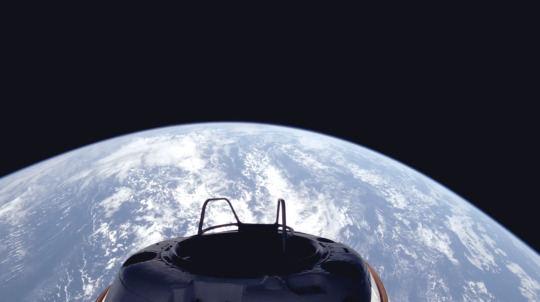
Dragon Polaris Dawn, first private commercial EVA or spacewalk imminent from the hatch of Dragon C207 Resilience, crew donning spacesuits...
youtube
0 notes
Text
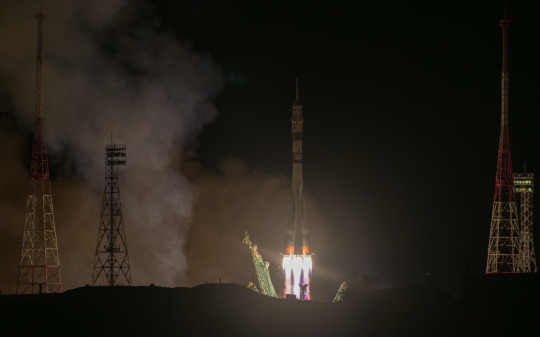
Launch of Soyuz MS-26/72S at 17:23BST today (11 Sep) with Expedition 72 crew onboard . Docking at 20:33BST after precision two orbit approach. Coverage from 19:30BST on NASA+
0 notes
Text

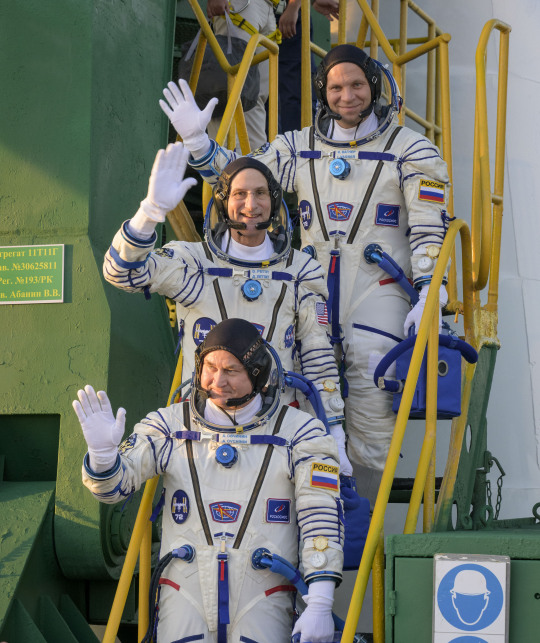

Launching at 17: 23BST today (11 Sep) will be Soyuz MS-26/72S with the first crew of Expedition 72 onboard. Soyuz Commander Lt Col Aleksei Ovchinin RussianAF (and Expedition 72 Commander), Fight Engineer Ian Vagner and veteran NASA astronaut Flight Engineer Donald Pettit. Pics: Roscosmos
0 notes
Text
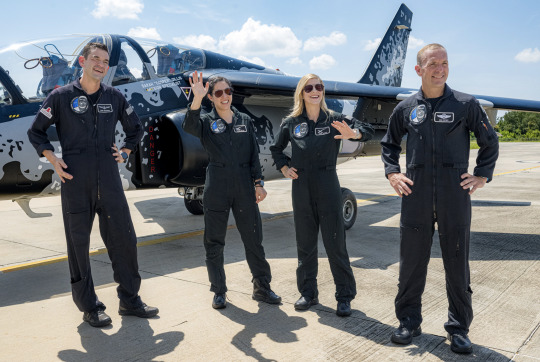
Update: Launch delayed due to thunder clouds within 10 miles of launch pad, new launch time of 10:23BST (09:23UT)
Polaris dawn is back on, tomorrow morning the second private independent flight Dragon mission, Polaris Dawn, will launch from LC-39A at Kennedy at 08:38BST. Billionaire Jared Isaacman is again paying for the mission, but this time in collaboration with SpaceX. The crew is seen here on their arrival at KSC on 19 August, in there Alpha Jets (Franco-German jet trainers). The crew left to right is Commander Jared Isaacman, Mission Specialist Sarah Gillis SpaceX, Medical Officer Anna Menon SpaceX and Lieutenant Colonel Scott Poteet USAF (ret).
The five day mission will attempt a record high (apogee) orbit of 190 x 1,400km (118x870mi), which will be higher than the record set by Gemini 11 in 1966, which attained 1,372km (853mi) (not counting the Apollo Lunar transfer orbits, which I suppose where not full orbits). Resilience will than drop down to a lower orbit of 750km when two of the crew will attempt the first private EVA. SpaceX has upgraded its IVA suits to EVA standard. Too do this the whole spacecraft will have to be depressurised (so all the crew need their suits on) and the hatch opened to space. Two of the crew, at least, will take turns standing in the hatchway on umbilicals (and tethered of course), rather than backpacks, in the same way that the first spacewalks were conducted in the early sixties. There won't be any free floating, off structure as it is termed.
C207 Resilience was also used for the first operational Crew Dragon mission to the ISS, USCV-1 or Crew 1, between 16 Nov 2020 to 2 May 2021 and the first independent mission, Inspiration4, also payed and flown on by Isaacman, on 16-18 Sep 2021.
Axiom Space has also charted SpaceX Dragon missions but these were three short commercial visits, with paying commercial astronauts, to the ISS in 2022 (AX-1), 2023 (AX-2) and 2024 (AX-3), another, AX-4, is planned for Oct-Nov 2024 and AX-5 in 2025 with an all British crew onboard. Pic: SpaceX
youtube
0 notes
Text

Starliner will finally, weather permitting, be returning early tomorrow morning (7 Sep UK time) but without its crew onboard. Coverage will begin on NASA TV (now called NASA+) at 22:45BST with the undocking scheduled for 23:04BST. In order to conduct the departure uncrewed with the minimum of software reconfigurations the Boeing Flight Control team will utilise a pre-planned trajectory which would normally be used in the event of a docking approach abort. After springs on the docking port push the vehicle away, about 30 seconds later, Starliner's forward thrusters will fire to rapidly (I'm guessing this will look like a much faster speed than we are used to seeing vehicles move near the station) send the vehicle up and forward of the station. This mode, a 'break-out' burn, would normally be used to rapidly get the vehicle away from the station in the event something went wrong during docking approach. Normally a vehicle would back away slowly in front of the station along its direction of travel, or velocity vector or V-bar, for some time before raising above and then back behind and below the station. Starliner will still travel above and than back behind the station but after some two orbits.
The all important deorbit burn will take place at 04:17BST with the landing, and it is a landing with airbags, not a splashdown, will occur at 05:04BST at White Sands Missile Range, New Mexico.
Starliner's crew, Captin Barry 'Butch' Wilmore and Captain Sunita Williams will remain onboard the ISS, in fact they will remain onboard the station now until February, becoming part of the next crew, Expedition 72. The next US crew mission will now launch with two crew instead of the four planed with two empty seats for Butch and Sunni to return on. As I predicted/guessed the crew will include Russian cosmonaut Alexandr Gorbunov (still designated as Mission Specialist despite now being in the Pilot seat) but instead of the assigned Commander, Nick Hague, who was originally assigned as pilot will now be in the Commander's seat. Zena Cardman (originally assigned as Commander despite being what would have been her first flight) and Stephanie Wilson have been kicked off their mission... thanks to Boeing (but they will be reassigned to a later expedition eventually). Pic: Starliner docked to the station, as seen from the Dragon parked above it, flying over Egypt.
Friday 6 September 2024: Undocking
BST (EDT)
22:45 (17:45) UNDOCKING COVERAGE NASA+
23:04 (18:04) undocking
Saturday 7 September 2024: Landing
03:50 (22:50 Fri) LANDING COVERAGE NASA+
04:17 (23:17 Fri) deorbit retro burn
05:03 (00:03) landing
05:30 (01:30) POST LANDING NEWS CONFERENCE NASA+
0 notes
Text
youtube
This mornings (5 Sep) launch of the last Vega launcher from ELV-1 Kourou, French Guiana. Video: ESA/Arianespace
0 notes
Text

Update: Launch postponed a day due to ground electrical problems. New launch time 5 Sept 2024 at 02:50BST (22:50GFT Tue)
Last launch of the Vega rocket (VV-24) early tomorrow morning (4 Sep) ESA's smallest launcher built by Avio in Italy, from French Guiana. It is being replaced by the upgraded but similar Vega C. So not very dramatic but it is still a last launch. Will be launching Sentinel 2C, built by Airbus, part of the EU/ESA Copernicus earth observation network, of which Britain is still a part of despite the best efforts of the Brexiteers. Pic: Arianespace.
0 notes
Text


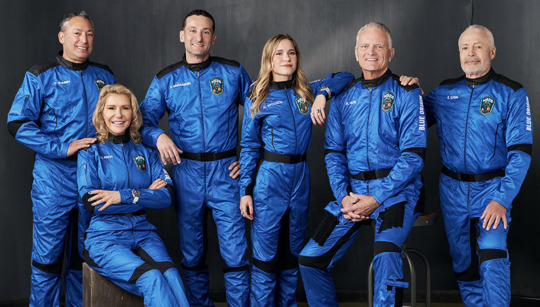
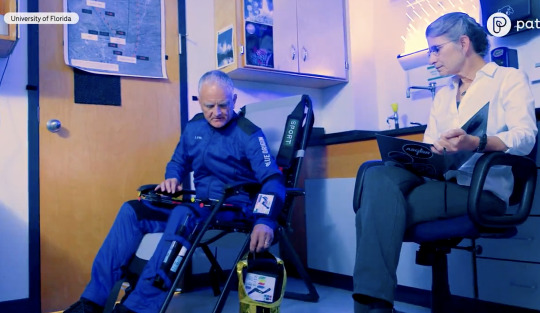
NS-26 New Shepard will be making launching its 26th sub-orbital flight at 14:00BST from Corn Ranch, Texas with six paying passengers onboard. It will be the 11th launch of the booster NS4 and the ninth flight of the crew capsule CC3 RSS First Step'.
Seat 1: Ephraim Rabin
Seat 2: Nicolina Rabin
Seat 3: Eugene Grin
Seat 4: Rob Ferl
Seat 5: Karsen Kitchen
Seat 6: Eiman Jahangir
Capcom: (Laura Styles ???)
The crew is (left to right in picture)
* Eugene Grin. Born in Ukraine, property financier. Lives in New York State.
* Nicolina Elrick
Model, property developer and IT venture capitalist. Based in Singapore. Certified helicopter pilot.
* Dr Elman Jahangir
Associate Professor of Medicine and Radiology and Cardilogist at Vanderbilt University Medical Centre. HIs flight is sponsored by the MoonDAO spaceflight development organisation.
* Karsen Kitchen
Will become the youngest woman to cross the Karman line. Senior st University of North Carolina at Chapel Hill majoring in communications & astronomy. She has worked as a research astronomer at Green Bank Observatory, West Virgina and UNC Morehead Planetarium. She has conducted centrifugal G-force tarning and aircaraft zero-G gravity flights. She is currently trianing for ther SCUBA diving licence.
* Rob Ferl
Professor at Astraeus Space Institute, University of Florida. Studying how living organiums responde to extreme conditions. Working with NASA has conducted numerous experiments on the ISS. HIs work has shown plants turn off certain genes on and off in responce to changes in gravity and proved plants can grow in Luna regolith (in an Apollo surface sample). Chair of National Academies of Sciences Committee. Ferl will operate a NASA funded experiment on this flight.
* Eugene Grin
Born in Ukraine, property financer. Lives in New York State.
The plant experiment is from the University of Florida Instiute of Food & Agricultural Sciences (UF IFAS) with principle investigators (as well as Ferl) Anna-Lisa Paul Director and Professor at UF IFAS Biotechnology Research and Jordan Callaham Reserach Coordinator UF IFAS Horticultural Science. Ferl will attach plant samples in eight syringe like 30cm long fixation tubes to his thighs and lower leg, after one set is activated on the ground he will activate one set at separation, and another before reentry (fix them in a fixation medium). A ground control sample will also be activated at the same time. This will study how plants react during the transition too and from micro-gravity, because they respond very quickly. Pics: Blue Origin & University of Florida. Coverage at Blue Origin...
youtube
0 notes
Text
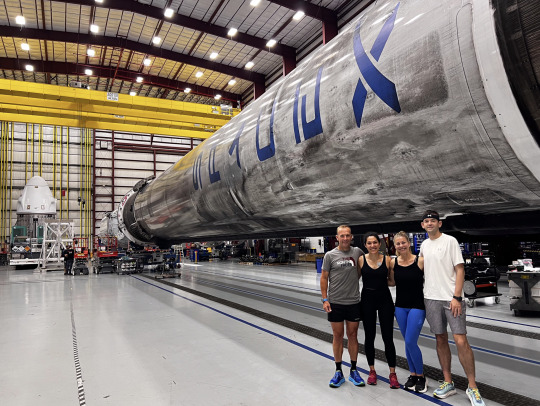
Update: Launch has been postponed a day to 28 August due to a ground side helium leak from the Quick Discount umbilical. Launch is scheduled for the same time at 08:38BST (03:38EDT) with a launch window extending to 12:09BST (07:09EDT). The back-up launch date is 29 August.
Tomorrow morning the second private independent flight Dragon mission, Polaris Dawn, will launch from LC-39A at Kennedy at 08:38BST. Billionaire Jared Isaacman (with the ears) is again paying for the mission, but this time in collaboration with SpaceX. The crew is seen here with booster B1083, which will be making it's fourth launch, which they have just 'signed' by writing in the soot (a new crew tradition) on 22 Aug in the integration building. Dragon C207 Resilience is in the background waiting to be attached, it will be its third flight. The crew left to right is Lieutenant Colonel Scott Poteet USAF (ret), Mission Specialist Sarah Gillis SpaceX. Medical Officer Anna Menon SpaceX and Commander Jared Isaacman.
The five day mission will attempt a record high (apogee) orbit of 190 x 1,400km (118x870mi), which will be higher than record set by Gemini 11 in 1966, which attained 1,372km (853mi) (not counting the Apollo Lunar transfer orbits, which I suppose where not full orbits). Resilience will than drop down to a lower orbit of 750km when two of the crew will attempt the first private EVA. SpaceX has upgraded its IVA suits to EVA standard. Too do this the whole spacecraft will have to be depressurised (so all the crew need their suits on) and the hatch opened to space. Two of the crew, at least, will take turns standing in the hatchway on umbilicals (and tethered of course), rather than backpacks, in the same way that the first spacewalks were conducted in the early sixties. There won't be any free floating, off structure as it is termed.
C207 Resilience was also used for the first operational Crew Dragon mission to the ISS, USCV-1 or Crew 1, between 16 Nov 2020 to 2 May 2021 and the first independent mission, Inspiration4, also payed and flown on by Isaacman, on 16-18 Sep 2021.
Axiom Space has also charted SpaceX Dragon missions but these were three short commercial visits, with paying commercial astronauts, to the ISS in 2022 (AX-1), 2023 (AX-2) and 2024 (AX-3), another, AX-4, is planned for Oct-Nov 2024 and AX-5 in 2025 with an all British crew onboard. Pic: SpaceX
Coverage on Twitter/X (so low quality) from around 04:30BST, but links also on you tube like this one...
youtube
0 notes
Text
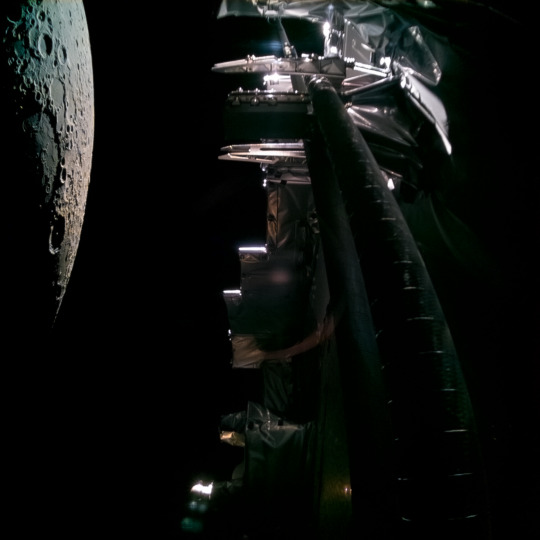
Taken by JUICE's other engineering camera, JMC2, last light during the fly-by of the Moon at 21:15UT. This cameras original purpose was to check the deployment of the radar boom which is the thing on the right. Right at the end of the boom at the top of the image you can see the blue crescent of Earth (almost a ring) peeking out (not the fuzzy patch, above that). This was taken soon after closest approach of 700km (435mi). JUICE will pass Earth at a distance of 6,807km (4230mi), way below geostationary orbit (so under things like satellite TV and weather satellites). There won't be any live coverage because it will make its close pass over the North Pacific and ESA does not have any ground stations around there. Its cameras and instruments will be on however recording. This will actually be a braking manoeuvre (as in letting the Earth pull to spacecraft back a bit) so it can head to Venus, arriving in August 2025 to get a boost to its speed then with a gravity assist from Venus. JUICE will enter orbit around Jupiter in July 2031. PIC: ESA JUICE JMC2
0 notes
Text
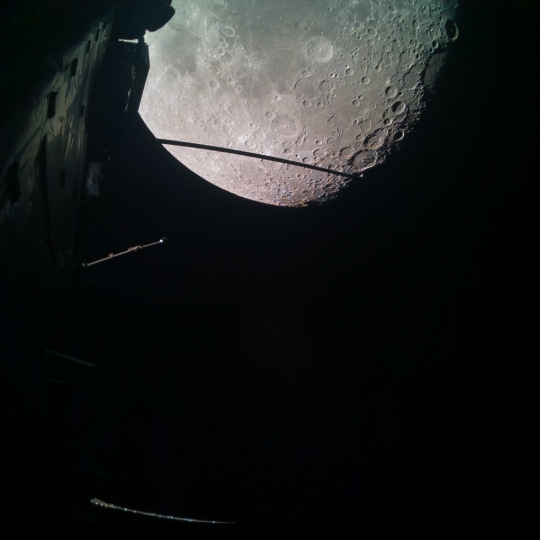
Taken by JUICE (Jupiter Icy Moon Explorer) as it passed the Moon last light. Taken by one of its engineering cameras, JM1 (Juice Monitoring Camera 1), at 21:25UT. These cameras were originally used for checking the arrays and antennas deployed OK. One of the high resolution science cameras, JANUS, was also operating during the pass taking surface pictures, but we will get those pictures later.
Apparently they said last night this double gravity assist (It is passing Earth later today-20 Aug), the first in history, is actually to slow the craft down a bit so it can head for Venus (in August 2025) and then get a bigger boost to its speed. This will give JUICE an increase in speed equivalent to if it was to fire its engines and use up all its propellent in one go, knocking six months off the journey time to Jupiter. Pic: ESA JUICE JMC1
0 notes
Text

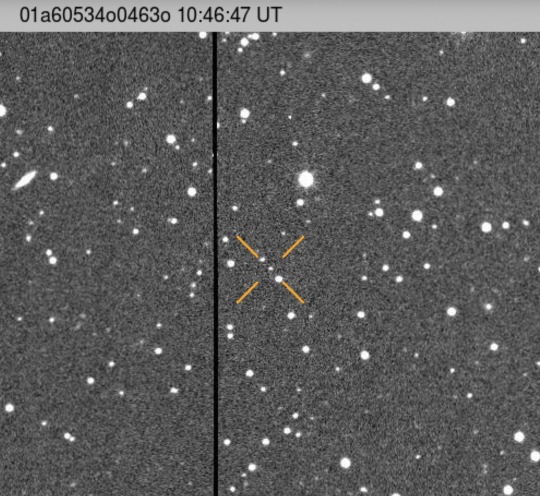
Automated Planetary Defense warning systems detected a 50m asteroid heading straight for us on 7 August. To everybody's relief this turned out to be the returning JUICE spacecraft coming back in for a gravity assisted boost to its speed.
JUICE was detected by ESA's Optical Ground Station in Tenerife, Spain on 7 August (top) and the NASA/University of Hawaii ATLAS NEO survey telescopes in Hawaii (bottom). Of course JUICE isn't 50m (163ft) across, it has an array span of 27.1m (89ft), but being metallic it reflects as much light as a 50m asteroid would. JUICE is making a close pass of the Moon tonight (19 Aug) and the Earth tomorrow (see previous post). Pics: ESA/NASA
0 notes